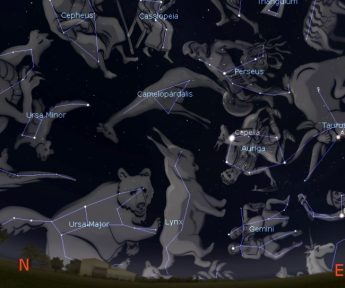This Week’s Sky at a Glance, 2025 Nov 22 – Nov 29
This Week’s Sky at a Glance, 2025 Nov 22 – Nov 29
By 1930 the borders of 88 constellations had been set to cover the entire sky by the International Astronomical Union (IAU), the overlords of all things astronomical. Many constellations were created by stargazers in Babylonia more than 6000 years ago, later to be adopted and expanded by the Greeks. Claudius Ptolemy’s second-century treatise, The Almagest, included a star map which included 48 constellations, most of which survived the IAU. A few centuries ago many constellations were made up for the newly “discovered” skies of the deep southern hemisphere and to fill in gaps in the familiar northern hemisphere. In New Brunswick we get to see all or parts of 66 constellations, but some are rather elusive.
Two of the gap-fillers lurk between the traditional autumn and winter constellations in the northeast these evenings, and they can be as difficult to see as their namesakes in New Brunswick. Stretching between Ursa Major and the Gemini-Auriga pair is a sparse zigzag of stars making the Lynx. Just as you are unlikely to see this cat near urban areas, you need to be in a rural region to spot Lynx. Between Lynx and the semicircle of Cepheus, Cassiopeia and Perseus is the enigmatic and tough-to-pronounce-after-a-few Camelopardalis, which of course is a giraffe. With its head near Polaris, a critter this far north should have been a reindeer. Before you have a few, go out and see if you can locate them.
This Week in the Solar System
Saturday’s sunrise is at 7:32 and sunset will occur at 4:48, giving 9 hours, 16 minutes of daylight. Next Saturday the Sun will rise at 7:41 and set at 4:43, giving 9 hours, 2 minutes of daylight.
The Moon is at first quarter next Friday Monday morning and near Saturn the following day. Mercury is half a binocular width above Venus Tuesday and Wednesday, rising about an hour before sunrise and climbing higher while brightening over the week. Saturn will be at its best for observing around 8 pm, and it reaches its second stationary point next Friday. This Saturday telescope users can catch Jupiter’s moon Europa and its shadow on opposite sides of the planet’s face around 10 pm, with the Red Spot approaching the middle. Mars is too close to the Sun for viewing; it will be in conjunction with the Sun early next year.
Tune in to the Sunday Night Astronomy Show at 8 pm on the YouTube channel and Facebook page of Astronomy by the Bay.

